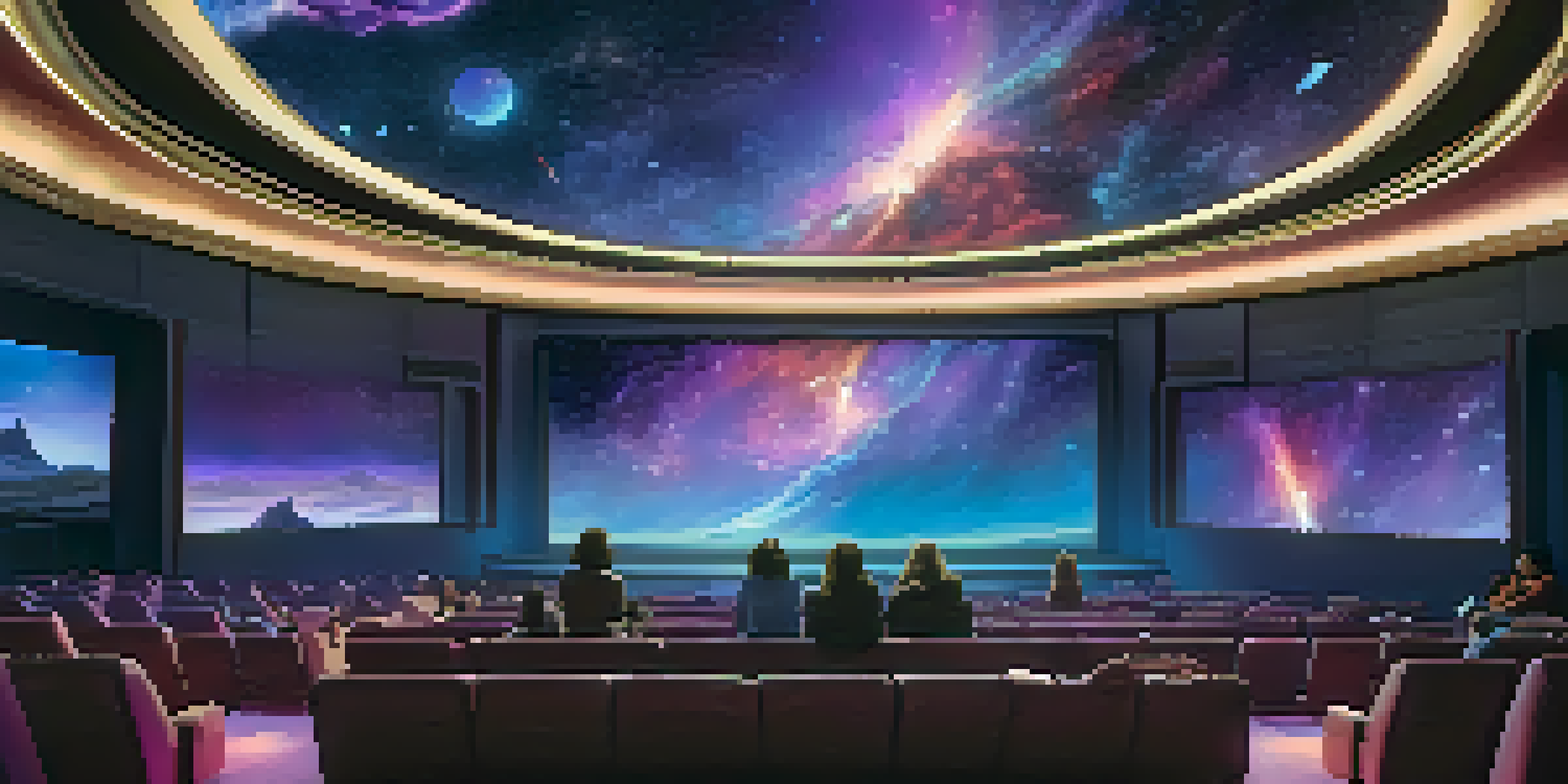Immersive Cinema and Its Influence on Viewer Emotions

What is Immersive Cinema and How Does It Work?
Immersive cinema is an innovative approach that engages viewers in a multi-sensory experience, often going beyond traditional storytelling. It utilizes advanced technology like 3D visuals, surround sound, and even virtual reality to create an environment where viewers feel part of the narrative. Think of it as stepping into a painting; the scene envelops you, making you feel as if you're walking through it.
Cinema is a matter of what's in the frame and what's out of it.
This form of cinema creates a heightened emotional response by appealing to our senses directly. When the visuals are vivid and the sound is enveloping, it can trigger feelings of joy, fear, or even nostalgia more profoundly than standard films. Imagine watching a horror movie where the sounds and visuals make you feel like you're in the haunted house rather than just watching from your couch.
As technology evolves, immersive cinema continues to push boundaries, inviting viewers into experiences that feel incredibly real. The aim is not just to tell a story but to make the audience live it, thereby forging a stronger emotional connection with the narrative.
The Psychology Behind Viewer Emotions in Cinema
Understanding the psychology of emotions is key to grasping how immersive cinema impacts viewers. Emotions are complex reactions that involve physiological responses, feelings, and cognitive processes. When immersed in a film, our brains engage in these processes, allowing us to experience emotions as if they were our own.

For example, when a character faces a life-or-death situation, viewers may experience a rush of adrenaline, mirroring the character's fear. This connection can be so intense that it can lead to physical responses, like a racing heartbeat or even tears during poignant moments. It's like being on a roller coaster; you feel the highs and lows as if they were happening to you.
Immersive cinema engages senses
By using advanced technology like 3D visuals and surround sound, immersive cinema creates a multi-sensory experience that draws viewers into the narrative.
This psychological engagement is what makes immersive cinema so effective. By creating environments that stimulate our senses, filmmakers can elicit genuine emotional reactions, leading to a more impactful viewing experience.
How Technology Enhances Emotional Engagement
Technology plays a pivotal role in enhancing emotional engagement in immersive cinema. Innovations such as virtual reality (VR) and augmented reality (AR) allow filmmakers to create experiences that engage viewers more deeply. Imagine donning a VR headset and finding yourself in the middle of a bustling city or a serene forest; the surroundings are so captivating that your emotions naturally align with the scene.
The best films are those that can engage our emotions and immerse us in their world.
Moreover, advancements in sound design, such as binaural audio, contribute significantly to the emotional landscape. This technology mimics the way humans hear sounds in real life, creating a 3D audio experience that can evoke feelings of comfort or anxiety depending on the scene. It's like listening to a symphony that resonates not just in your ears, but in your heart.
As filmmakers continue to leverage these technologies, the emotional impact of cinema will only grow stronger. The goal is to create experiences that resonate with audiences, allowing them to feel a spectrum of emotions while exploring stories in a way that feels profoundly personal.
Case Studies: Films That Changed Viewer Emotions
Several films exemplify the power of immersive cinema in evoking strong emotions. For instance, 'Gravity' uses stunning visuals and sound design to place viewers in the vastness of space, creating a sense of isolation and fear. When the characters float helplessly among the stars, audiences can't help but feel their dread, as if they're experiencing it with them.
Another great example is 'The Lion King,' particularly with its use of music to heighten emotional moments. The combination of visuals, sound, and storytelling can lead to tears during key scenes, such as Mufasa's death. This emotional engagement is heightened when combined with immersive elements, making the heartbreak feel even more profound.
Technology enhances emotional impact
Innovations such as virtual reality and binaural audio deepen viewer engagement, allowing for a more profound emotional connection with the story.
These case studies show how immersive cinema can transform the viewing experience. By tapping into viewer emotions through innovative techniques, these films leave a lasting impact long after the credits roll.
The Role of Storytelling in Immersive Cinema
At the heart of immersive cinema lies the art of storytelling. A compelling narrative is essential for guiding viewer emotions, providing context that enhances the immersive experience. When viewers care about the characters and their journeys, the emotional stakes become higher, making the experience more impactful.
For instance, interactive narratives where viewers can influence the outcome create an even deeper connection. When you feel like your choices matter, the emotional investment in the story escalates. It's akin to playing a video game where your decisions can lead to triumph or tragedy—every choice heightens the emotional stakes.
Ultimately, effective storytelling in immersive cinema is about building a relationship between the audience and the narrative. The more viewers relate to the story, the more likely they are to experience a range of emotions that resonate deeply with them.
Emotional Responses: The Good and the Bad
While immersive cinema can evoke powerful emotions, it's important to acknowledge that not all reactions are positive. For some viewers, intense emotional experiences can lead to discomfort or anxiety, especially in films that explore darker themes. It's essential for filmmakers to strike a balance between engagement and emotional safety.
For example, horror films often utilize immersive techniques to create fear, but this can overwhelm some viewers. The goal should be to elicit emotions that resonate without crossing the line into distress. Filmmakers must consider their audience and provide content warnings when necessary, allowing viewers to prepare for what lies ahead.
Storytelling drives emotional responses
Effective storytelling in immersive cinema builds a relationship between the audience and the narrative, heightening emotional stakes and engagement.
On the flip side, the ability to evoke strong emotions can also lead to catharsis—an emotional release that can be healing. Many people find solace in films that resonate with their own experiences, fostering a sense of connection and understanding. Thus, while the emotional responses can be varied, they also highlight the power of immersive cinema in shaping our feelings.
The Future of Immersive Cinema and Viewer Emotions
Looking ahead, the future of immersive cinema seems bright, with technology continuing to evolve and enhance emotional experiences. Virtual reality, augmented reality, and even artificial intelligence are set to revolutionize how stories are told and experienced. These advancements will likely lead to even more engaging narratives that resonate deeply with audiences.
As filmmakers embrace these technologies, we can anticipate a shift in how stories are structured. Interactive storytelling may become more prevalent, allowing viewers to navigate their emotional journeys actively. Imagine being able to choose a character's path and feeling the emotional weight of those decisions firsthand.

Ultimately, the fusion of technology and storytelling will shape the landscape of immersive cinema. As we explore new ways to evoke emotions, we’ll likely find that the connection between viewers and cinema becomes deeper, more personal, and increasingly transformative.